PSY260 Lecture 3: Nonassociative learning
1/31
There's no tags or description
Looks like no tags are added yet.
Name | Mastery | Learn | Test | Matching | Spaced |
|---|
No study sessions yet.
32 Terms
Habituation
“Simplest form of learning“
Decrease in the strength or occurrence of a behaviour due to repeated exposure to the stimulus that produces the behaviour
Acoustic Startle Behaviour
Initially, rodents respond to a loud noise with a reflexive muscular response (jump/freeze)
After many repeated trials where the noise is not followed by any danger, the response decreases
Rodents are made to think that the stimulus is unimportant because nothing follows it
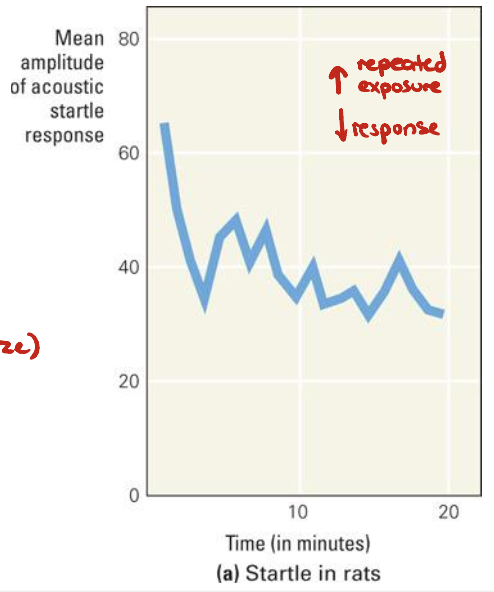
Infant Viewing Patterns
Initially, infants fixate on a new visual stimulus
After many repeated trials of seeing the same stimulus, infants appear to lose interest
They stare longer at novel stimuli
Habituation → ↓ staring
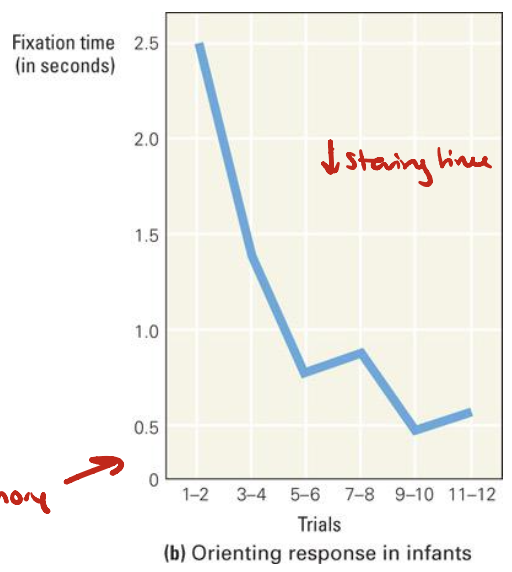
Characteristics of Habituation
Habituation is ubiquitous → found throughout the animal kingdom
10 key characteristics
Decrease in Response
Repeated application of a stimulus results in a progressive decrease in some parameter of a response to an asymptotic level
Decrease is often exponential, but may also be linear
We sometimes see an initial period of sensitization before this decrease in response
Small response increase, then larger decrease
Ex. Acoustic startle
Starts at baseline behaviour
Repeated stimulus presentation → ↓ response intensity
Reaches some asymptote and levels off
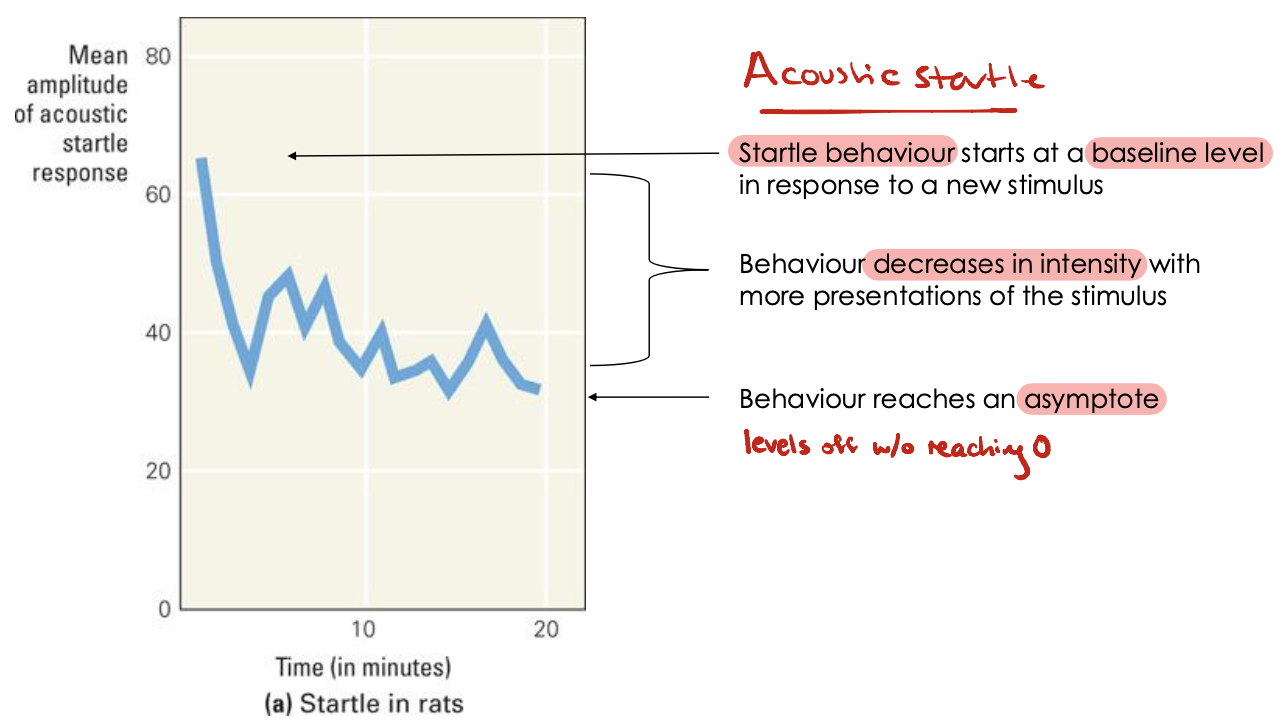
Spontaneous Recovery
If the stimulus stops and some time passes, behaviour gradually returns to normal
Spontaneous because all it needs to recover is the passing of time
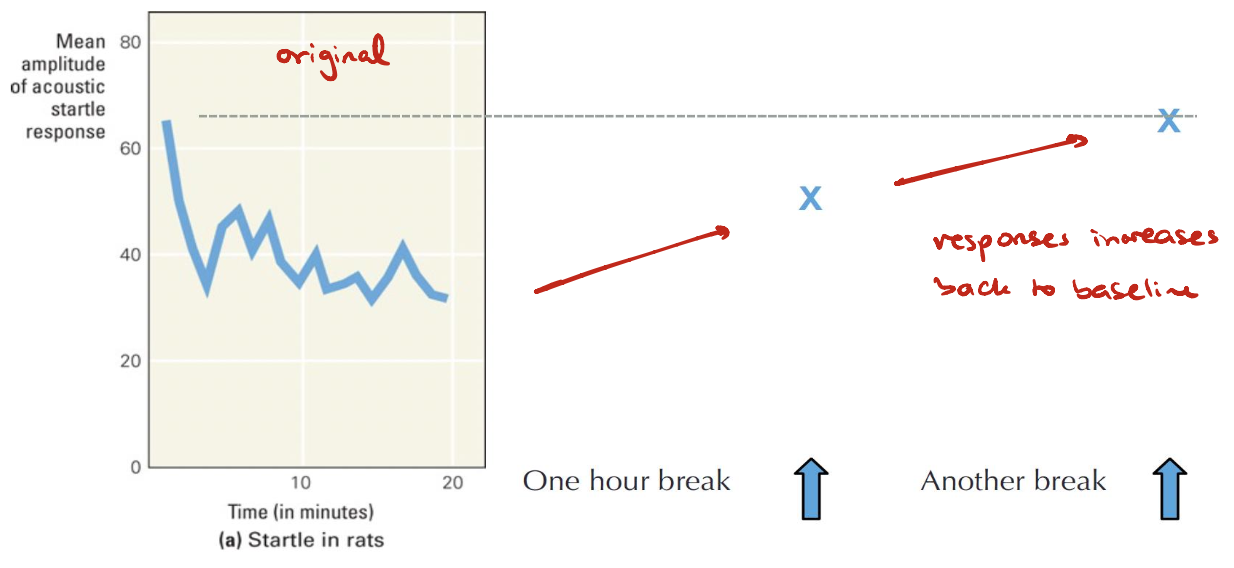
Potentiation of Habituation
After multiple series of stimulus repetitions and spontaneous recoveries, the response decrease becomes more rapid and more pronounced
Many repetitions of habituation/spontaneous recovery → effects become more permanent
Baseline is reduces
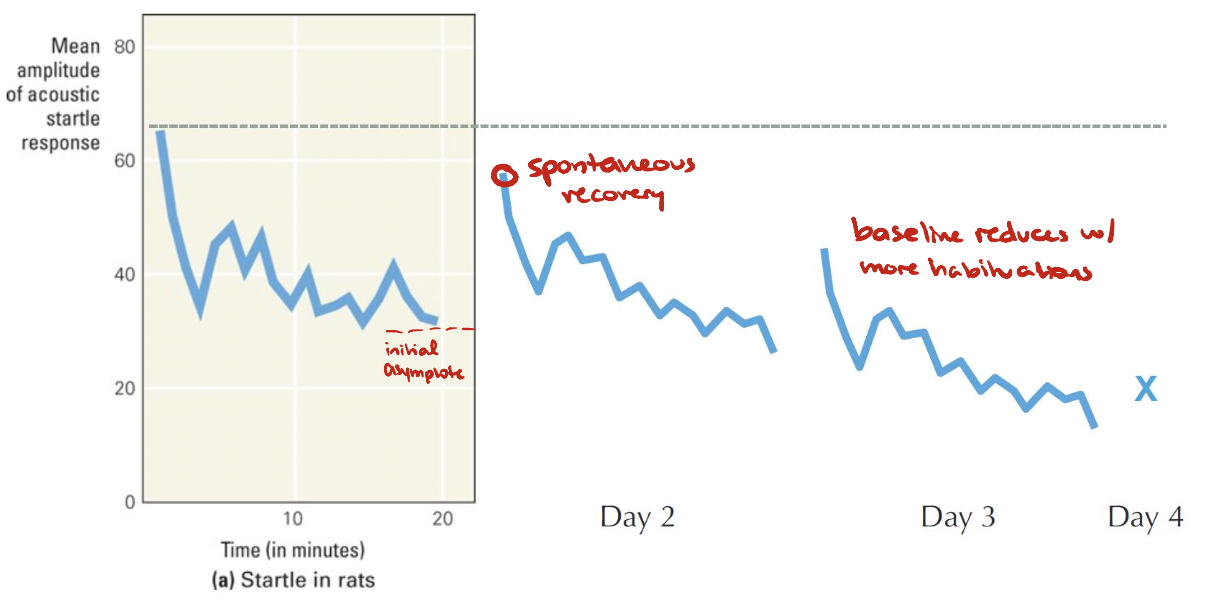
Frequency of Stimulation
Taking breaks between sessions of repeated stimuli makes habituation develop more slowly but last much longer
Ex. studying → spaced repetition vs. cramming
More frequent stimulation → quicker and more pronounced habituation
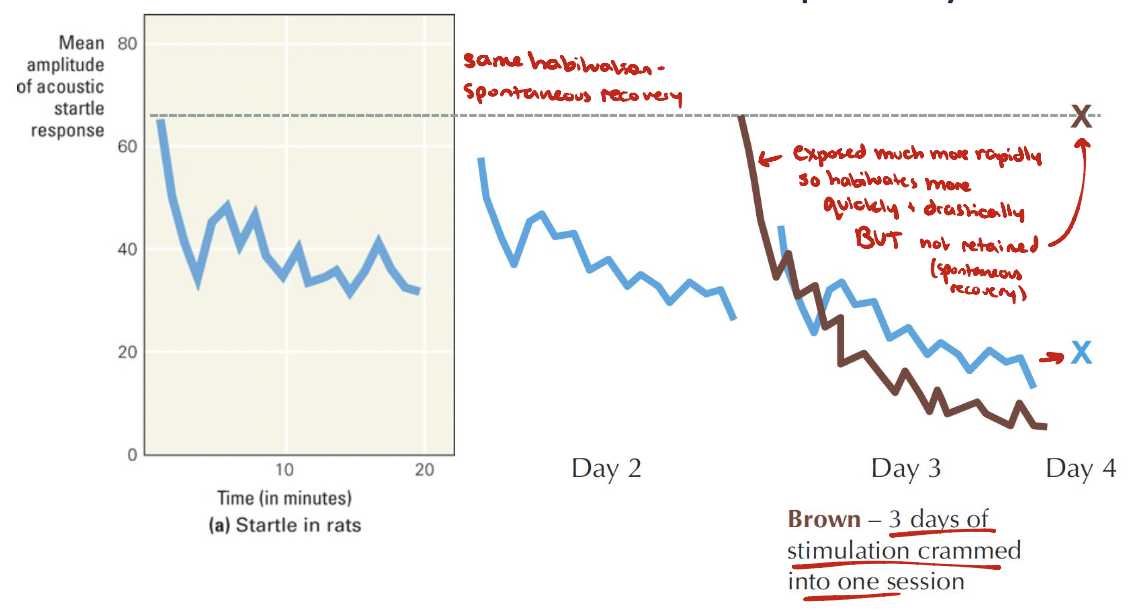
Weaker Stimulus = More Habituation
The less intense the stimulus, the more rapid and pronounced the habituation process
Stronger stimulus → less habituation
Weak/useless stimuli are ignored, but stronger/painful stimuli are more likely to be important and will get attention
Noxious stimuli → sensitization
Makes sense because weaker stimuli are less likley to be important and easier to get used to
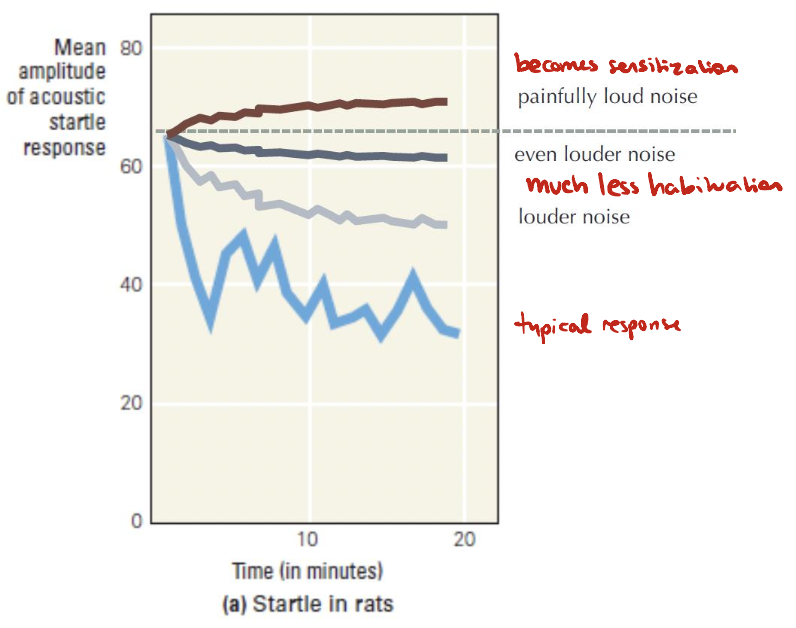
Effects can Accumulate Beyond Behavioural Asymptotic Level
Asymptote for behavioural response can be at or above 0
Additional habituation training beyond the asymptotic level can be observed as delayed onset of spontaneous recover
Habituation seems to continue even after we can measure
Habituation training continues beyond asymptotic level
“Overlearning“
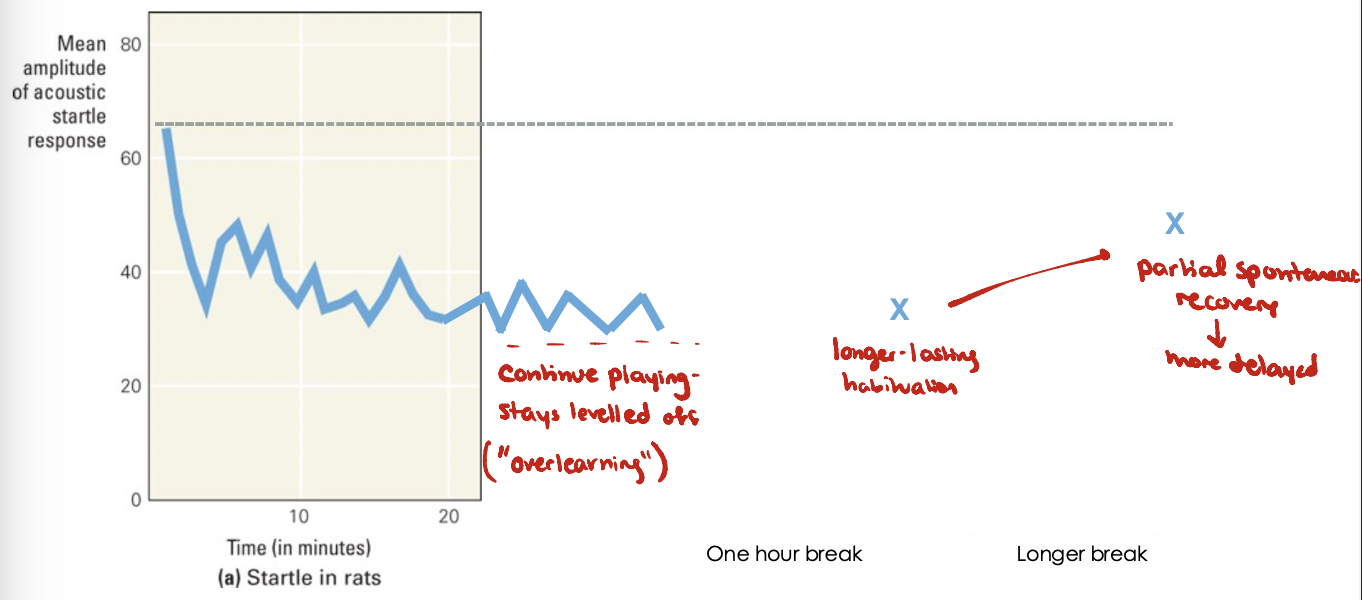
Stimulus Generalization
Within the same stimulus modality, the response decrease shows some stimulus specificity
Generally, responses only decrease to the habituating stimulus (specific)
Very similar stimuli → may have some generalization
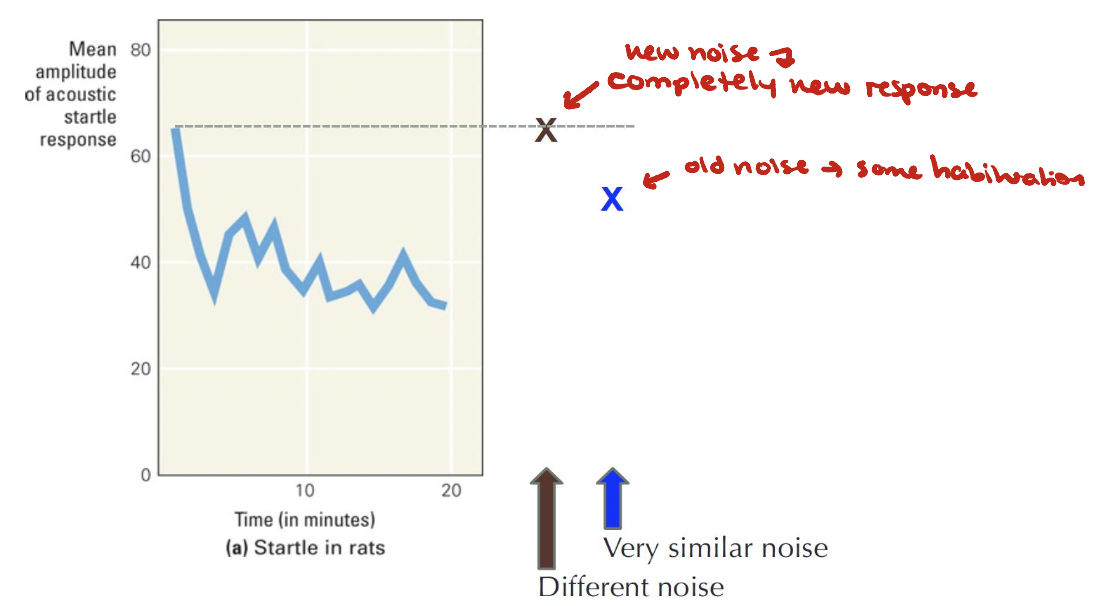
Dishabituation
Presentation of a different stimulus results in an increase of the decremented response to the original stimulus
New stimulus can temporarily recover repsonses to habituated stimulus
Fades quickly if the original stimulus is presented repeatedly again
Recovery, but not spontaneous → because a new stimulus is presented
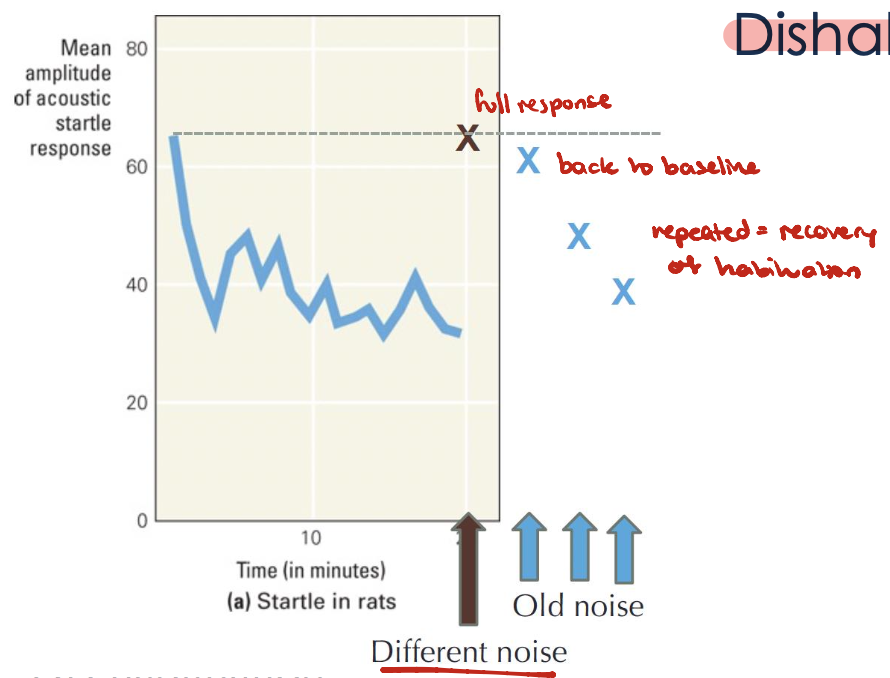
Habituation of Dishabituation
Repeated application of the dishabituating stimulus → amount of dishabituation decreases
You “habituate“ to the “dishabituating stimulus“ so that your original response doesn’t recover as much
If you present the different noise multiple times, it will gradually lead to less recovery of the initial response
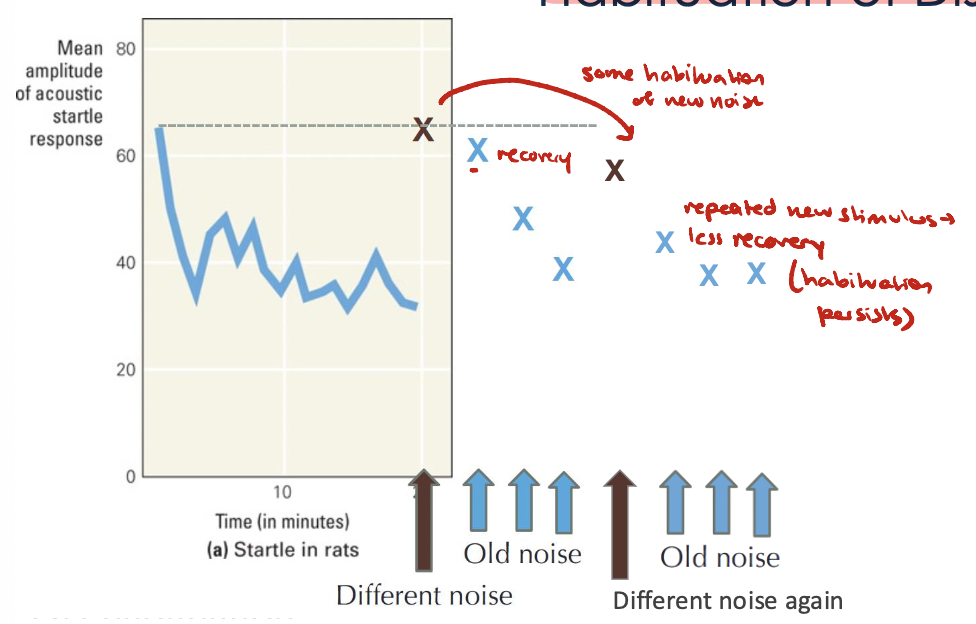
Long-term Habituation
Some stimulus repetition protocols may result in properties of the response decrement that last long-term
Long-lasting memory for habituation training
Believed to be related to changes in protein synthesis, LTD
Short-term Habituation
Repeated stimulation depletes transmission:
Synaptic depression
Presynaptic neuron: reduction in neurotransmitter release (uses up glutamate in available vesicles)
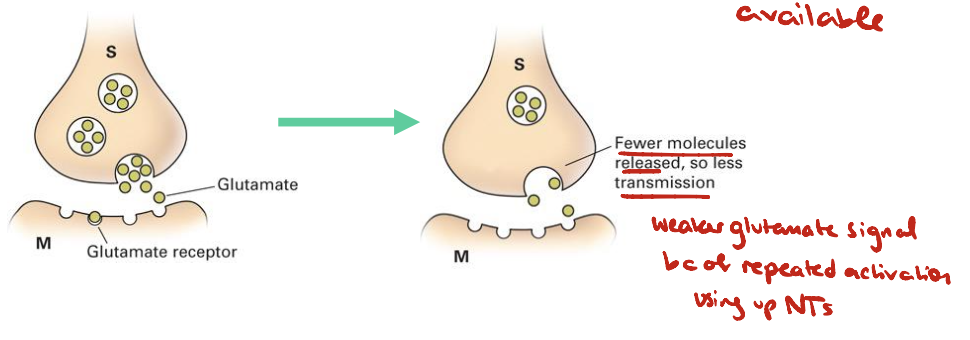
Long-term Habituation
Related to LTD
Presynaptic neuron:
May produce less NT over time (not just using it up, but producing less)
May alter neurotransmitter reuptake (may stay in synapse or not last as long)
Postsynaptic neuron:
Receptos can become less responsive and less sensitive to NTs
Can lead to ↓ # of receptors on the membrane
Some sensory-motor synapses actually get entirely pruned away (most extreme)
Can also alter gene expression
These are the most long-term changes
Sensitization
Increase in the strength or occurrence of a behaviour due to exposure to an arousal or noxious stimulus
Stimulus is environmentally informative → we want to keep the response to it
Avoid pain in future
Sensitization: More Acoustic Startle
Initial habituation to settle animals to a stable baseline (for sake of study)
Foot shock applied at dashed line to the experiimental group only
Shock = noxious stimulus
Sensitization → increased responding to startle stimulus (tone) after shock
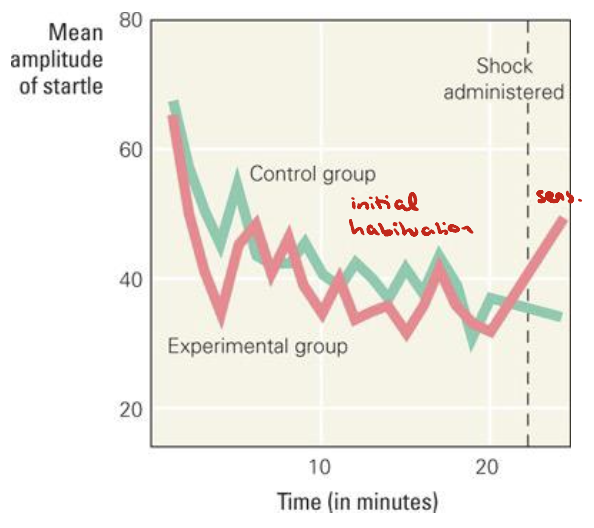
Characteristics of Sensitization
Sensitization is also ubiquitous → found throughout animal kingdom
Set of common characteristics:
Noxious (painful) stimuli work better than weak
More generalization, less stimulus specificity (compared to habituation)
Can develop with just a single trial → enough to identify noxious stimulus and get sensitized
Mechanism to increase responses to stimuli that are important (alert)
Sensitization vs. Habituation
Habituation
Decreases behaviour
Innocuous stimulus
Repeated exposure
Stimulus specific
Sensitization
Increases behaviour
Noxious stimulus → environmentally relevant
Single trial (more can help)
Generalizes across stimuli
Types of Sensitization
Peripheral sensitization
Central sensitization
Peripheral sensitization
Occurs in peripheral nerves
PNS
When tissues are damaged/inflamed, sensory nerves can become more responsive. to pain signals
Ex. burn your hand → hurts when something else non-painful touches it
Central sensitization
Occurs within brain and spinal cord
CNS
This is more relevant to us
Role of Sensitization in Pain
Both peripheral and central sensitization can lead to allodynia and hyperalgesia
Allodynia: ↑ response to non-painful stimuli
Hyperalgesia: increased pain sensitivity (↑ response to painful stimuli)
Aplysia Californica
Habituation
Initially, touching the siphon leads to retraction of the gill
Repeatedly touching the siphon with a non-painful, benign stimulus leads to reduction in gill retraction (↓ sensitivity)
Sensitization
If the touch is paired with a painful shock to the tail, this can override the habituation and lead to increased gill retraction after future siphon touches (↑ sensitivity)
Aplysia Californica: Baseline circuitry
Siphon: attached to sensory neuron
Tail: attached to sensory neuron
Gill: motor neuron
Pathway:
Sensory neuron detects benign tough on siphon
Sensory neuron triggers glutamate release at synapses on interneuron and motor neuron of gill
Triggers gill retraction
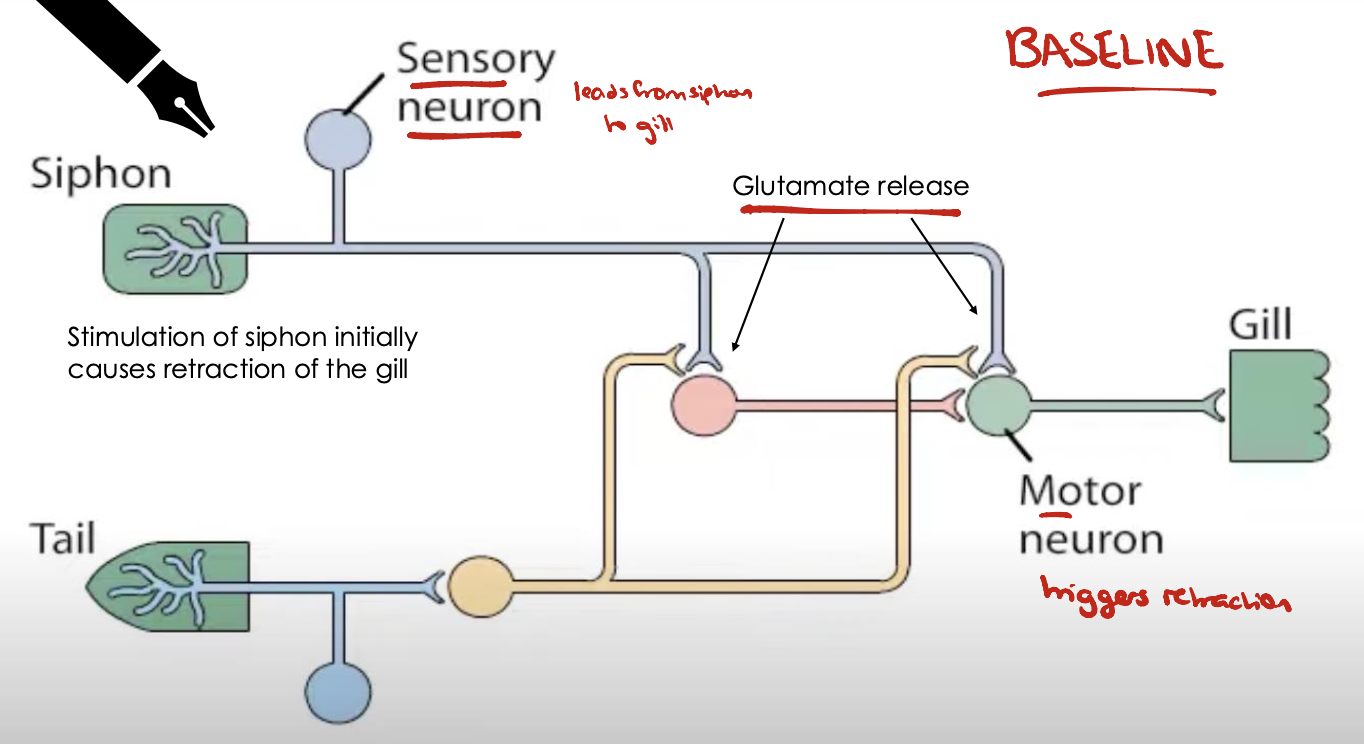
Aplysia Californica: Habituation
Repeated stimulation of siphon eventually leads to habituation → ↓ gill retraction
Sensory neuron triggers glutamate release, triggering motor neuron to retract gill
Repetition: glutamate gets used up
↓ NT release → ↓ motor neuron stimulation
↓ retraction response (habituation)
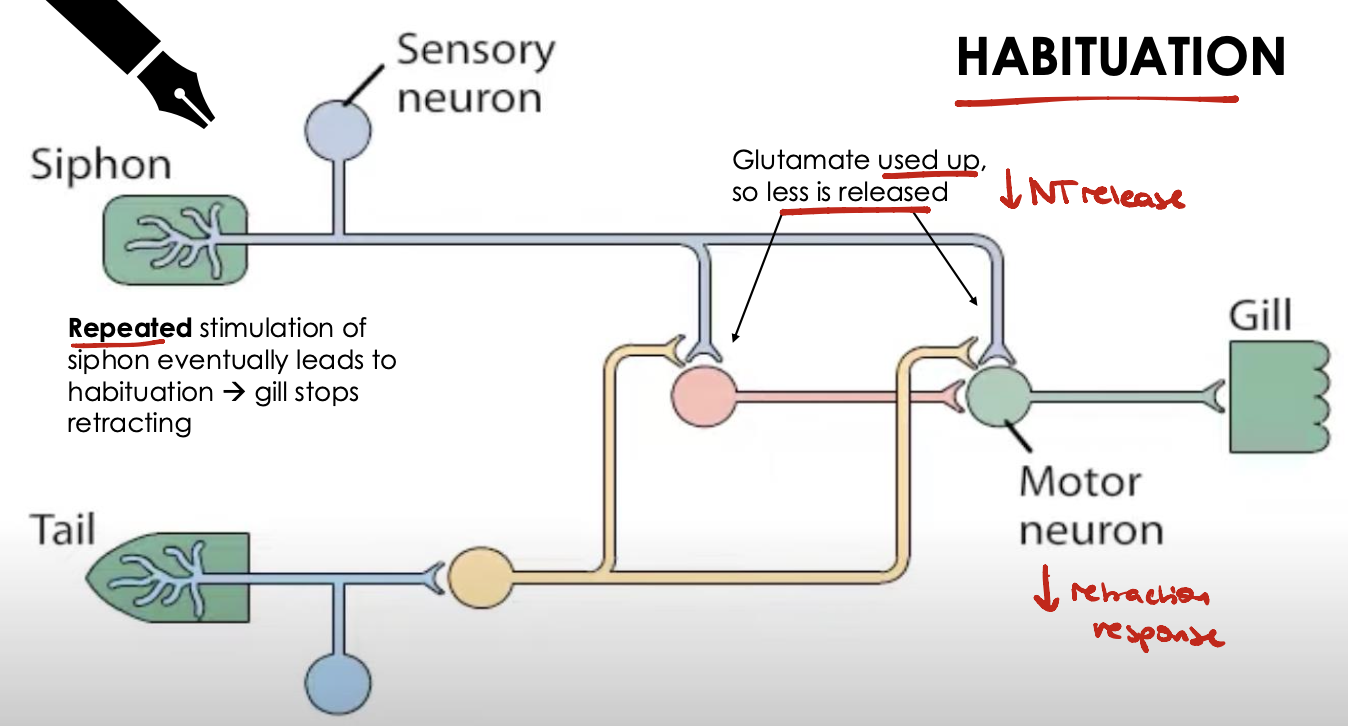
Aplysia Californica: Sensitization
After habituation to siphon touch, introducing a shock to the tail can immediately cause gill retraction behaviour to increase again in response to siphon touch
Shock to tail triggers tail sensory neuron
Passes signal to modulatory interneuron
Modulatory interneuron releases serotonin to override reduced glutamate release → trigger motor neuron firing → ↑ gill retraction
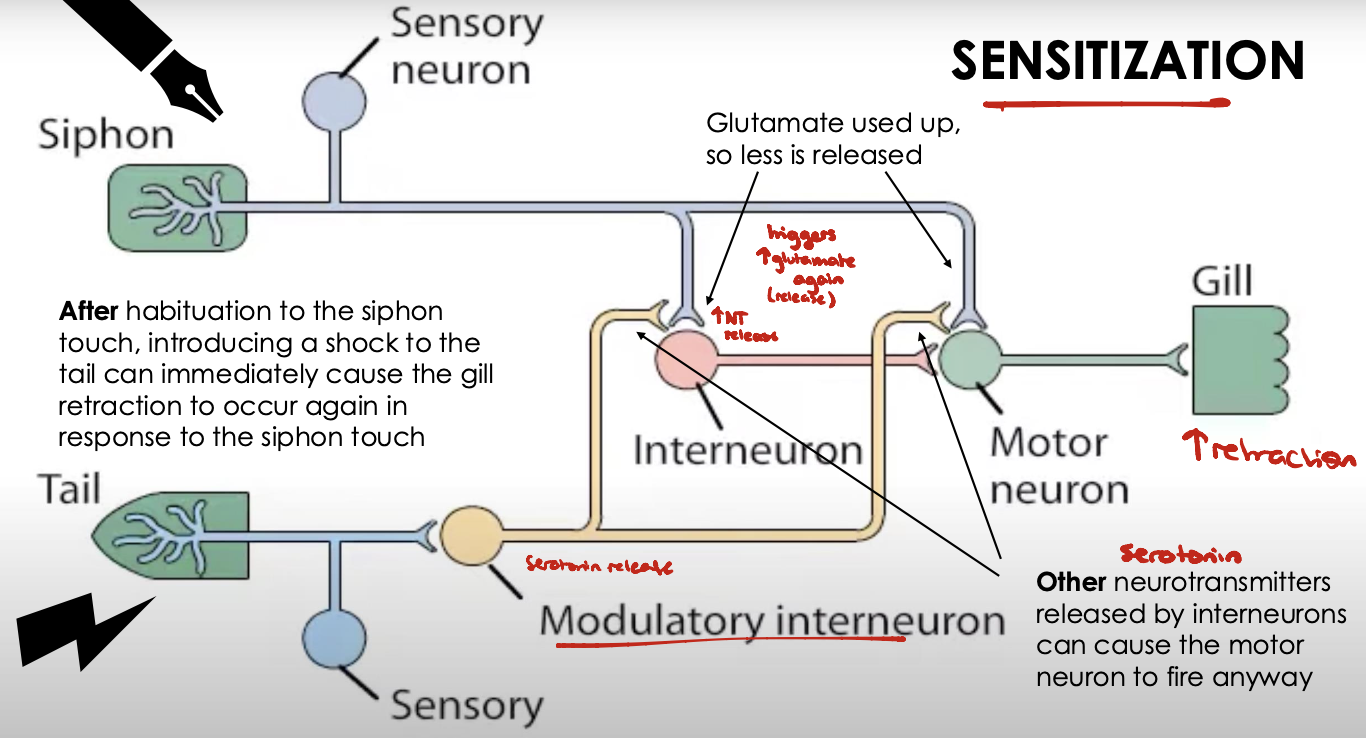
Mechanisms of Sensitization
New/stronger synaptic connections between neurons
Increase in NT release
Typically excitatory NTs (glutamate)
Modulatory interneurons can override habituated responses in the presence of pain
In Aplysia, this is done via release of serotonin
Familiarization
Reduction in the sense of novelty (sense that something is new) as an individual becomes more acquainted with a stimulus/environment
Similar to the concept of habituation
Related to integrating stimuli into new or existing schemas
Ex. walking into class 3+ times → you recognize it and it feels familiar
Improved ability to recognize/process a particular stimulus
Increase synchrony and efficiency of neural pathways (LTP and LTD both play a role)
Familiarization: Remember-Know Paradigms
Remembering: conscious recollection of specific details about a past event
Active recall of detail
Knowing: a feeling of familiarity without specific details
Sense that you know without knowing detail
Tip-of-the-tongue
Aplysia Video
Repeated touching of gill reduces gill withdrawal behaviour → habituation
Shock to tail → sensitization → gill withdrawal returns
Repeated pairing of tail and siphon stimuli can cause prolonged sensitization
Abdominal ganglion: holds many of the cell bodies involved in this behaviour
Connects to gill and siphon nerves
Siphon: sensory neurons with release glutamate onto interneurons and gill motor neurons → gill retraction
Habituation: glutamate release is depressed, gill withdrawal weakens
Tail shock: sensory neurons synapse onto modulatory interneurons, which release serotonin onto interneurons and motor neurons → override reduced response and gill retraction returns
Short-term: lasts ~ 1 hour